Introductory information about some well-known introduced seaweeds which are studied in the INVASIVES project can be found below:
Sargassum muticum
Sargassum muticum is an invasive brown alga which spread to Europe in the 1970’s. It normally grows to around 1-3 m in length, although it can be much longer and form large floating mats, blocking out light to other seaweeds. S. muticum has a number of invasive traits, such as wide environmental tolerances, fast growth and good dispersal1. Observational and experimental work indicates that S. muticum can have negative effects on native vegetation2, such as kelps3, fucoid seaweeds4,5 and seagrass6,7.
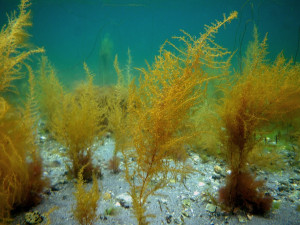 Sargassum muticum. Photo: Vivian Husa Sargassum muticum. Photo: Vivian Husa |
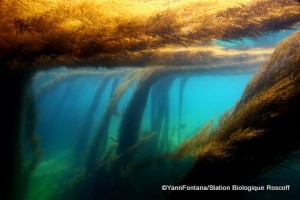 Sargassum muticum (France). Photo: Yann Fontana, Station Biologique Roscoff (CNRS UPMC) Sargassum muticum (France). Photo: Yann Fontana, Station Biologique Roscoff (CNRS UPMC) |
 Sargassum muticum (Norway). Photo: Mette Eilertsen Sargassum muticum (Norway). Photo: Mette Eilertsen |
Codium fragile subsp. fragile
Codium fragile subsp. fragile (previously subsp. tomentosoides) is a siphonous green alga, with a spongy branched thallus that can grow up to 1 m in length. It is normally found growing in sheltered areas with hard substratum. It was introduced sometime during the 1800’s8, and now grows many places in Europe up to mid-Norway. Studies on the species associated with C. fragile suggest it can support a wide variety of animals and epiphytic algae, although the community differs from that on native seaweeds9-11. C. fragile may also compete with important native habitat-forming seaweeds such as fucoids and kelps12,13.
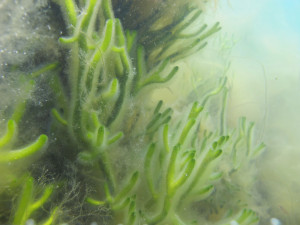 Codium fragile. Photo: Caroline Armitage |
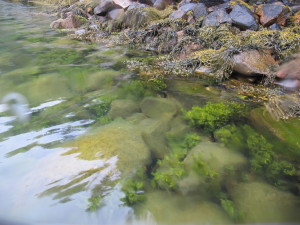 Codium fragile (Norway). Photo: Caroline Armitage |
 Codium fragile. Photo: Caroline Armitage |
Bonnemaisonia hamifera
Bonnemaisonia hamifera is a red branched alga that is usually found in the subtidal zone. It exists in two forms: a small bushy red thallus (“trailiella” form) which produces spores, and a larger branched gamete-producing form with hooked branches. In the ‘trailiella’ form it can grow in dense zones, and the species has been observed monopolising space in the NW Atlantic14. It can grow epiphytically on native seaweeds such as Corallina officinalis, and also produce chemicals which prevent settlement of native seaweeds15.
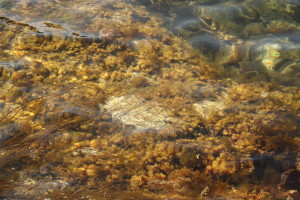 Bonnemaisonia hamifera (Norway). Photo: Vivian Husa |
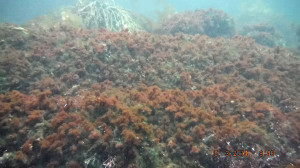 Bonnemaisonia hamifera (Norway). Photo: Caroline Armitage |
Fucus serratus
Fucus serratus is native to most of Europe, but has been accidentally introduced to Iceland and the NW Atlantic. It is a branching brown alga, which can be found dominating the lower intertidal zone on rocky shores. In Iceland it may hybridise with the native Fucus distichus.
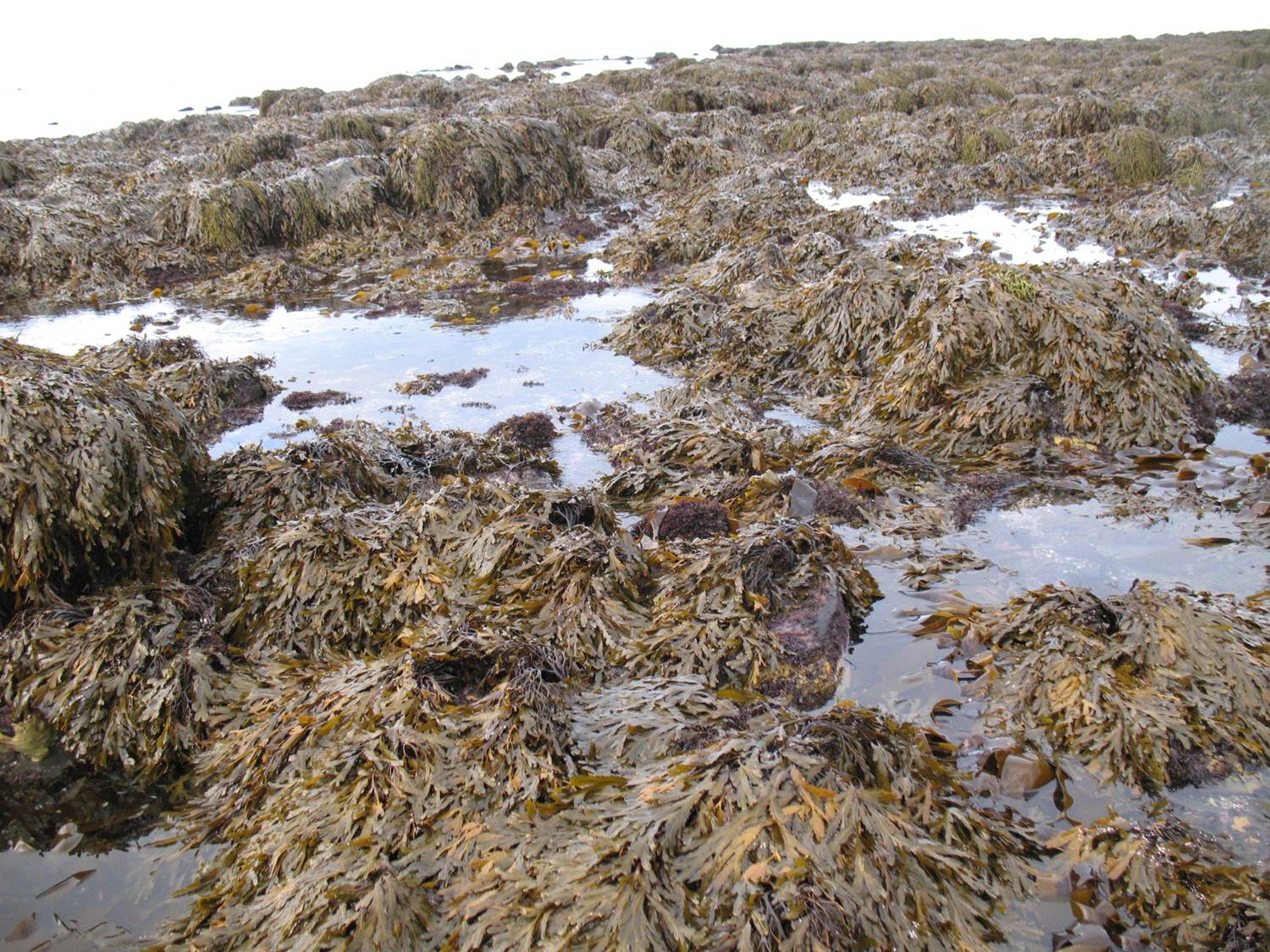 F. serratus in Iceland. Photo: Kjersti Sjøtun |
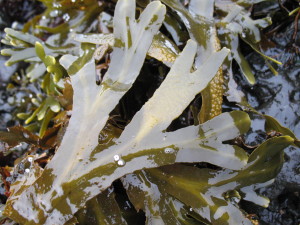 F. serratus- F. distichus hybrid (Iceland). Photo: Kjersti Sjøtun. |
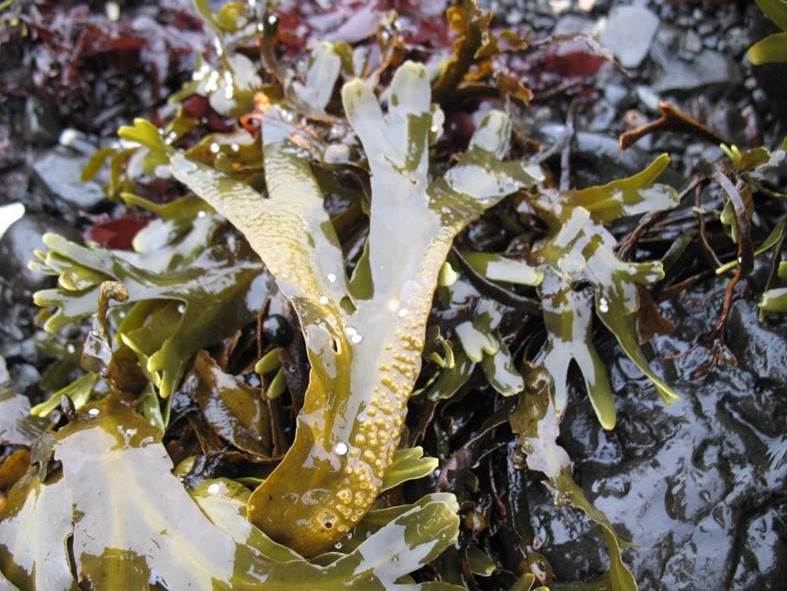 F. serratus – F. distichus hybrid (Iceland). Photo: Kjersti Sjøtun |
References
1Rueness, J. 1989. Sargassum muticum and other introduced Japanese macroalgae: Biological pollution of European coasts. Mar. Pollut. Bull. 20:173-176.
2Schaffelke, B. and C. L. Hewitt. 2007. Impacts of introduced seaweeds. Bot. Mar. 50:397-417.
3Britton-Simmons, K. H. 2004. Direct and indirect effects of the introduced alga Sargassum muticum on benthic, subtidal communities of Washington State, USA. Mar. Ecol. Prog. Ser. 277:61-78.
4Stæhr, P. A., Pedersen, M. F., Thomsen, M. S., Wernberg, T., Krause-Jensen, D. 2000. Invasion of Sargassum muticum in Limfjorden (Denmark) and its possible impact on the indigenous macroalgal community. Mar. Ecol. Prog. Ser 207: 79-88.
5Salvaterra, T., D. S. Green, T. P. Crowe, and E. J. O’Gorman. 2013. Impacts of the invasive macroalga Sargassum muticum on ecosystem functioning and food web structure. Biological invasions 15:2563-2576.
den Hartog, C. 1997. Is Sargassum muticum a threat to eelgrass beds? Aquatic botany 58(1): 37-41.
7Tweedley, J. R., E. L. Jackson and M. J. Attrill. 2008. Zostera marina beds enhance the attachment of Sargassum muticum in soft sediments. Marine Ecology Progress Series 354: 305-309.
8Provan, J., D. Booth, N. P. Todd, G. E. Beatty, and C. A. Maggs. 2008. Tracking biological invasions in space and time: elucidating the invasive history of the green alga Codium fragile using old DNA. Divers. Distrib. 14:343-354.
9Schmidt, A. L. and R. E. Scheibling. 2006. A comparison of epifauna and epiphytes on native kelps (Laminaria species) and an invasive alga (Codium fragile ssp. tomentosoides) in Nova Scotia, Canada. Botanica Marina 49(4): 315-330
10Jones, E. and C. S. Thornber (2010). Effects of habitat-modifying invasive macroalgae on epiphytic algal communities. Marine Ecology Progress Series 400: 87-100.
11Lutz, M., et al. (2010). Non-indigenous macroalga hosts different epiphytic assemblages to conspecific natives in southeast Australia. Marine Biology 157(5): 1095-1103.
12Scheibing, R. E. and P. Gagnon. 2006. Compeitive interactions between the invasive green alga Codium fragile spp. tomentosoides and native canopy-forming seaweeds in Nova Scotia (Canada). Marine Ecology Progress Series 325: 1-14.
13Armitage C.S., Sjøtun K., Jensen K.H. (2014). Correlative evidence for competition between Fucus serratus and the introduced chlorophyte Codium fragile subsp. fragile on the southwest coast of Norway. Botanica Marina 57: 85-97 DOI 10.1515/bot-2013-0087
14Harris, L. G. and Tyrell, M. C. 2001. Changing community states in the Gulf of Maine: Synergism between invaders, overfishing and climate change. Biolgical invasions 3:9-21.
15Svensson, J. R., G. M. Nylund, G. Cervin, G. B. Toth, and H. Pavia. 2013. Novel chemical weapon of an exotic macroalga inhibits recruitment of native competitors in the invaded range. J. Ecol. 101:140-148.
All images belong to their respective owners and may not be used without written permission.
